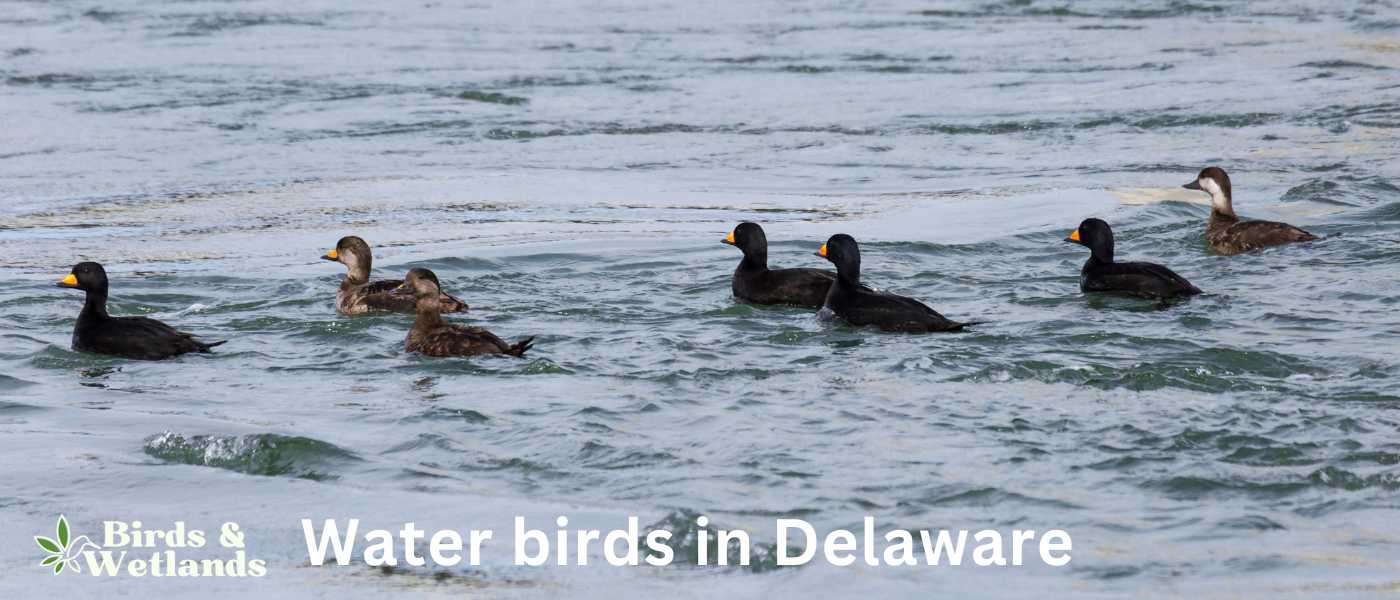Delaware may be the second smallest state in the US, but its avian richness is far from lacking. Its strategic location along the Atlantic Flyway, combined with the presence of numerous wetlands, rivers, and coastal areas, makes it a hotspot for a variety of water birds. These creatures add a distinct vibrancy to the state’s ecosystems, engaging visitors and residents alike with their unique displays of colors and behaviors.
As you delve into the world of water birds in Delaware, you’re set to embark on an enriching journey through an integral part of the state’s natural beauty and biodiversity.
Delaware water birds
| Water Bird Species | Frequency in Delaware | Specific Locations in Delaware |
|---|---|---|
| American White Pelican | Rare | Bombay Hook NWR, occasionally in other coastal areas |
| Brown Pelican | Uncommon | Delaware Bay, Indian River Inlet |
| Double-Crested Cormorant | Very Common | Delaware Bay, inland lakes and ponds |
| Great Blue Heron | Very Common | Bombay Hook NWR, Delaware River |
| Great Egret | Common | Bombay Hook NWR, Delaware Bay |
| Snowy Egret | Common | Delaware Bay, Bombay Hook NWR |
| Green Heron | Common | Inland lakes and ponds, Bombay Hook NWR |
| Black-Crowned Night-Heron | Common | Delaware River, Bombay Hook NWR |
| Yellow-Crowned Night-Heron | Uncommon | Bombay Hook NWR, occasionally in coastal marshes |
| Glossy Ibis | Uncommon | Delaware Bay, Bombay Hook NWR |
| American Coot | Common | Inland lakes and ponds, Delaware River |
| Mallard | Very Common | Just about any water body in the state |
| Wood Duck | Very Common | Inland lakes and ponds, Delaware River |
| Common Merganser | Uncommon | Delaware River, occasionally inland waters |
| Hooded Merganser | Common | Delaware River, inland lakes and ponds |
| Red-Breasted Merganser | Uncommon | Delaware Bay, coastal waters |
| American Black Duck | Very Common | Delaware Bay, inland lakes and ponds |
| Blue-Winged Teal | Common | Bombay Hook NWR, Delaware Bay |
| Northern Pintail | Common | Bombay Hook NWR, Delaware Bay |
| Green-Winged Teal | Common | Delaware Bay, Bombay Hook NWR |
| Ring-Necked Duck | Common | Inland lakes and ponds, Delaware River |
| Canvasback | Uncommon | Delaware Bay, Bombay Hook NWR |
| Redhead | Rare | Occasionally sighted at Delaware Bay |
| Common Goldeneye | Uncommon | Delaware Bay, coastal waters |
| American Wigeon | Common | Bombay Hook NWR, Delaware Bay |
| Northern Shoveler | Common | Bombay Hook NWR, Delaware Bay |
Water Bird Species Found in Delaware
American White Pelican


| Feature | Measurement |
|---|---|
| Scientific Name | Pelecanus erythrorhynchos |
| Length | 50–70 in |
| Wingspan | 95–120 in |
| Weight | 3.5 and 13.6 kg |
The American White Pelican (Pelecanus erythrorhynchos) is one of North America’s largest birds, distinguished by its brilliant white plumage, elongated orange bill, and massive wingspan, which can extend up to 3 meters. This bird has a unique appearance with its distinctive pouch used for feeding and a “horn” on the upper part of the bill during the breeding season. Though a large bird, it is very graceful in flight, often seen soaring in flocks in a V formation.
American White Pelicans inhabit lakes, marshes, and salt bays, and despite their size, they are excellent swimmers. They feed primarily on fish, using a cooperative hunting strategy where they encircle schools of fish in shallow water and then scoop them up in their bill pouches. Unlike their brown pelican relatives, they do not dive for their food. During the breeding season, these pelicans will nest in colonies on islands in freshwater lakes.
Brown Pelican (Pelecanus occidentalis)
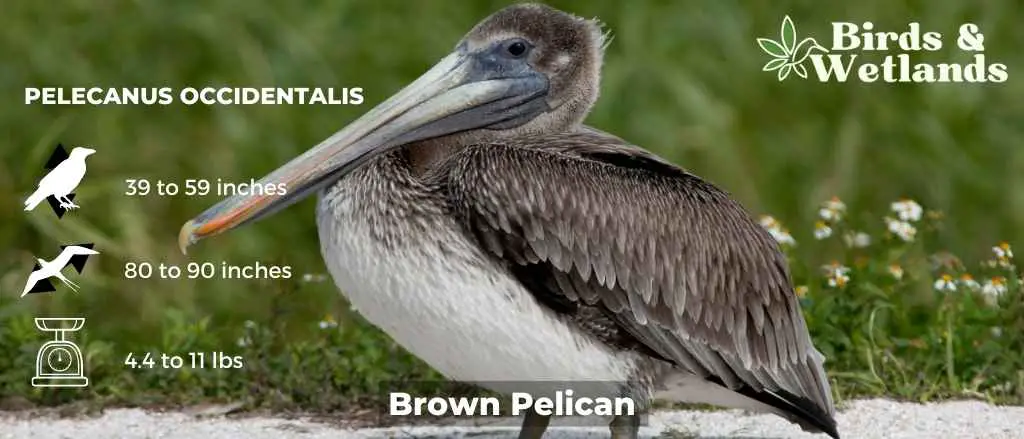
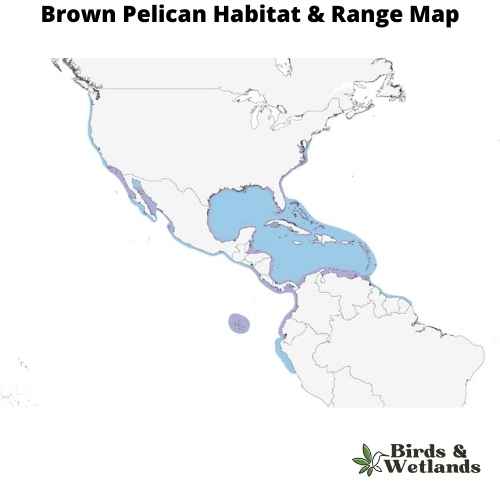
Listen:
Scientific Name: Pelecanus occidentalis
Length: 3 ft 3 in to 5 ft 0 in
Wingspan: 6 ft 8 in to 7 ft 6 in
Weight: 4.4 to 11.0 lb
The Brown Pelican is a large water bird famous for its distinct body shape and dramatic feeding habits. Known for their habit of diving headfirst into the water to catch fish, they are a staple along the coasts of the southern United States.
Appearance: Brown Pelicans are easily identifiable due to their long, curved necks, stout bodies, and large bills with a stretchy pouch. As their name suggests, they have brown and gray body feathers, with a paler head and neck that can become yellowish in breeding season.
Diet: Their diet mainly consists of fish, which they catch by making spectacular plunging dives from the air, scooping up the fish in their expandable bill pouches. They then drain the water from their pouches before swallowing their catch.
Reproduction: Brown Pelicans nest in colonies on islands, laying 2 to 3 eggs in nests made from sticks and vegetation. Both parents share incubation and feeding duties. After hatching, the chicks remain in the nest for around 12 weeks before they are ready to leave.
Double-crested cormorant

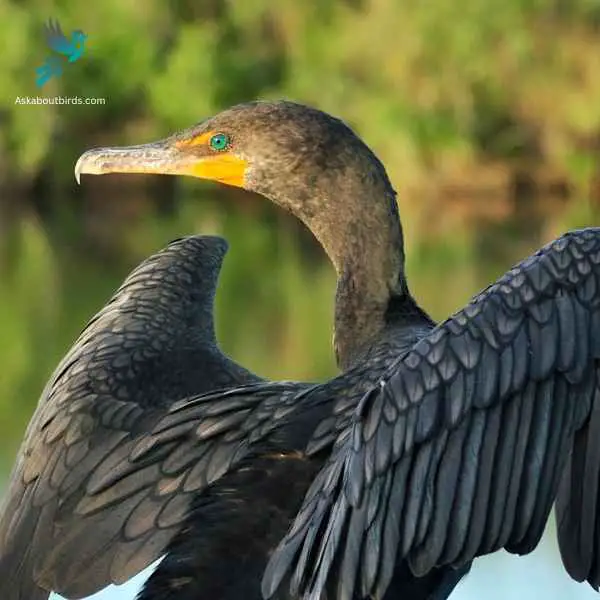
| Feature | Measurement |
|---|---|
| Scientific Name | Nannopterum auritum |
| Length | 28–35 in |
| Wingspan | 45–48 in |
| Weight | 1.2–2.5 kg |
The Double-Crested Cormorant (Phalacrocorax auritus) is a large waterbird known for its long neck, hooked bill, and almost entirely black body. The species gets its name from the two small patches of tufted feathers or “crests” found on the heads of breeding adults, one on each side. These birds are strong swimmers that propel themselves underwater with their webbed feet, their bodies submerged and necks above the water surface, giving them a characteristic snake-like appearance when swimming.
Double-Crested Cormorants are widely distributed across North America and can be found in a variety of aquatic environments including freshwater lakes, coastal areas, and rivers. Their diet primarily consists of fish, which they catch by diving from the water’s surface. Often seen perched with wings outstretched to dry after fishing, these cormorants nest in trees, on the ground, or on cliff edges, usually in colonies. While they have rebounded from decreases in the mid-20th century due to DDT-related reproductive failures, they face ongoing threats from habitat loss, entanglement in fishing gear, and conflicts with fisheries over their consumption of fish. Protection and careful management of their habitats are key to their ongoing conservation.
Great Blue Heron


| Feature | Measurement |
|---|---|
| Scientific Name | Ardea herodias |
| Length | 36–54 in |
| Wingspan | 66–79 in |
| Weight | 1.82–3.6 kgs |
Great Blue Herons are the largest heron species in North America, is distinguished by its tall stature and unique blue-gray plumage.
Measuring up to 4.5 feet tall with a wingspan of approximately 6.5 feet, the bird features a long, pointed bill, a white head with a black eye stripe extending to slender black plumes, and robust, elongated legs. Its distinctive flight pattern, forming a tight “S” shape with its neck, sets it apart from similar large birds, like cranes.
Inhabiting various wetland habitats, including marshes, lakes, rivers, and coastal regions throughout much of North and Central America, the Great Blue Heron is a wading bird. Often seen poised statue-like at the water’s edge, these birds are expert hunters, spearing fish and capturing small animals with their sharp bills.
Great Egret


| Feature | Measurement |
|---|---|
| Scientific Name | Ardea alba |
| Length | 31 to 41 in |
| Wingspan | 52 to 67 in |
| Weight | 1.5 to 3.3 lbs |
The Great Egret (Ardea alba), also known as the Common Egret, is a large, elegant wading bird recognized for its brilliant white plumage, slender black legs, and long, dagger-like yellow bill.
With a height of up to 3.3 feet and a wingspan of 52 to 67 inches, this bird is amongst the largest of the heron species. Its stately appearance and serene comportment have made it a popular symbol in many cultures and an eye-catching sight in its habitats.
Found across all continents except Antarctica, the Great Egret resides in both fresh and saltwater wetlands, including marshes, ponds, and coastal areas. It feeds mainly on fish, but it also hunts amphibians, small mammals, and invertebrates.
Snowy Egret

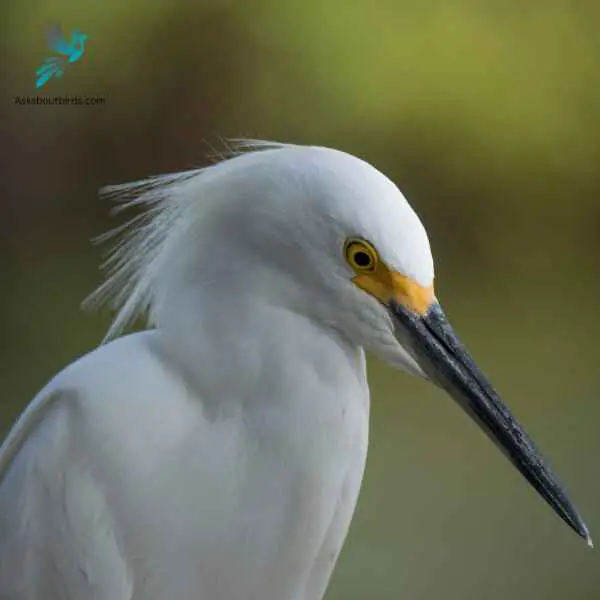
| Feature | Measurement |
|---|---|
| Scientific Name | Egretta thula |
| Length | 22.1–26.0 in |
| Wingspan | 39.4 in |
| Weight | 370 g |
The Snowy Egret (Egretta thula) is a small and active wading bird, celebrated for its delicate beauty. It sports an entirely white plumage that appears to glow against its black bill and legs, and striking yellow feet, which often play a crucial role in luring prey during feeding.
The Snowy Egret is further adorned with fine, plume-like feathers on its head, neck, and back during the breeding season, making it one of the more distinctive heron species.
Inhabiting wetland areas across the Americas, the Snowy Egret can be found in marshes, swamps, shorelines, and tidal flats where it feeds primarily on fish, but also consumes insects, crustaceans, and small reptiles.
Green Heron

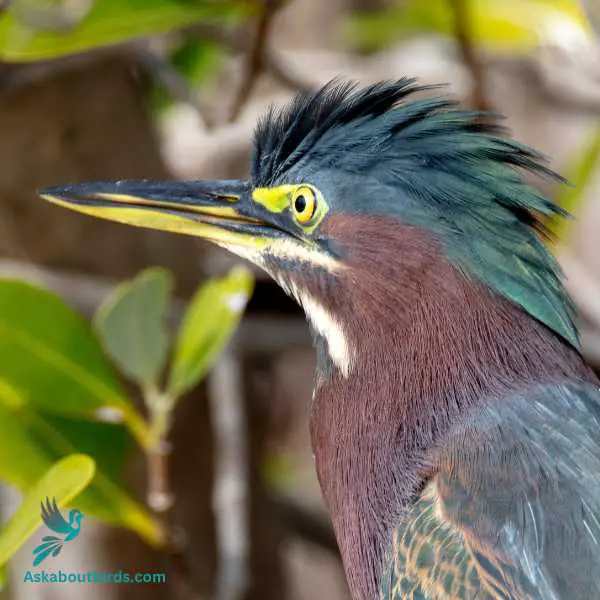
| Feature | Measurement |
|---|---|
| Scientific Name | Butorides virescens |
| Length | 16-18 inches |
| Wingspan | 25-27 inches |
| Weight | 6-7 ounces |
The Green Heron is a small heron found in North America, notable for its deep green back and chestnut body, as well as its unique fishing tactics.
Appearance: Green Herons are dark and compact birds with a glossy, greenish-black cap, a greenish back and wings, and chestnut neck and belly. The bill is long, dark and sharply pointed. Their legs are bright orange or yellow. Young birds are duller in color, with a dark top and streaked brown front.
Diet: The Green Heron’s diet is quite varied, consisting mostly of small fish, but also includes insects, spiders, and sometimes amphibians and small mammals. It’s known for its tool-using behavior where it drops bait onto the water’s surface to attract fish.
Reproduction: Green Herons are solitary birds except during the breeding season, where they form monogamous pairs. Nests are typically built in trees or shrubs near water. Females lay 2 to 5 pale blue-green eggs that both parents incubate.
Black-Crowned Night-Heron
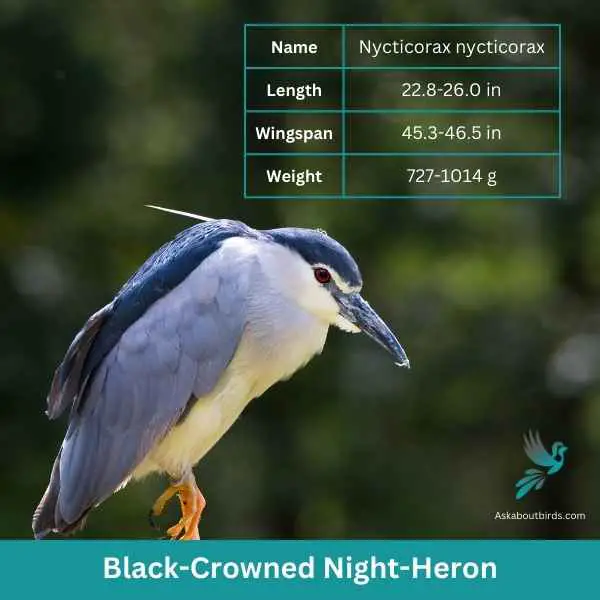
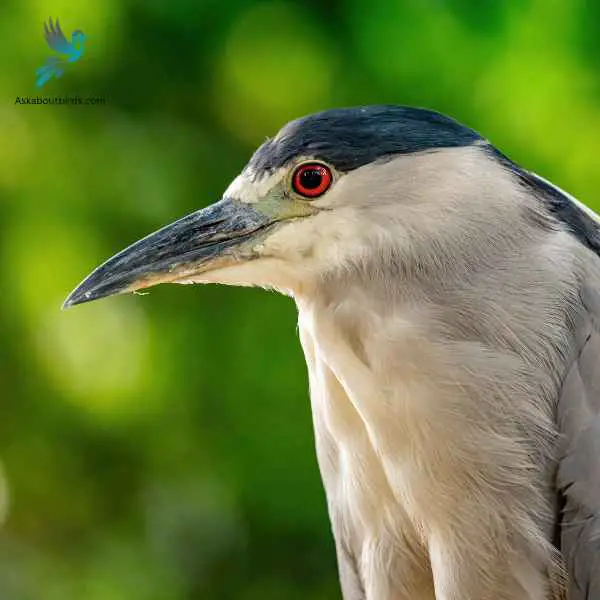
| Feature | Measurement |
|---|---|
| Scientific Name | Nycticorax nycticorax |
| Length | 22.8-26.0 in |
| Wingspan | 45.3-46.5 in |
| Weight | 727-1014 g |
The Black-Crowned Night-Heron (Nycticorax nycticorax) is a medium-sized heron species known for its distinct nocturnal habits and characteristic appearance. The bird displays a stocky silhouette, with a black crown and back, contrasting starkly with its light grey wings and white underparts.
Its eyes are large and red, adapted for its night-time activities, and its legs are relatively short for a heron. The bill is sturdy and black, and during the breeding season, two to three long white plumes extend from the back of the head.
Residing in a wide variety of wetland habitats, from freshwater marshes to coastal regions, the Black-Crowned Night-Heron is found across a large global range, including the Americas, Europe, Asia, and Africa. The species primarily feeds on fish and invertebrates, but it is known to be opportunistic and will also eat small mammals, birds, and eggs.
Yellow-crowned Night-Heron (Nyctanassa violacea)

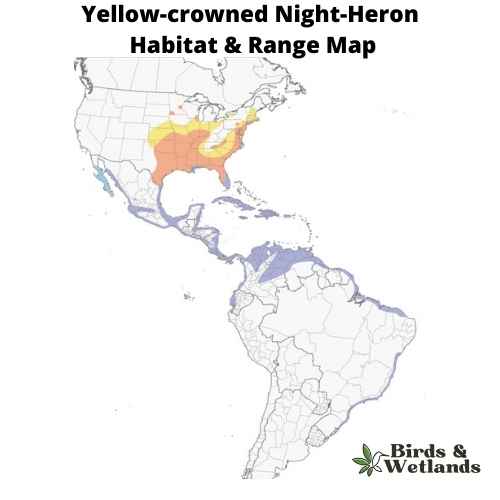
Listen:
Scientific Name: Nyctanassa violacea
Length: 1 ft 10 in – 2 ft 4 in
Wingspan:
Weight: 1.43–1.87 lb
The Yellow-crowned Night Heron is a medium-sized heron commonly found in wetlands and coastal habitats across the southeastern United States.
Appearance: Yellow-crowned Night Herons have a sturdy body with a comparatively short neck and legs. Their distinctive feature is their namesake yellow crown, which contrasts sharply with their gray body and back. They have red eyes and a heavy, dark bill. During the breeding season, they develop long, wispy plumes on their head, giving them a stylish appearance.
Diet: Yellow-crowned Night Herons are known for their preference for crustaceans, especially crabs and crayfish. They hunt mostly at night, stalking their prey in shallow water, often remaining still for long periods before striking quickly with their bill.
Reproduction: Yellow-crowned Night Herons nest in small colonies, typically in trees or shrubs near water. The female lays 3 to 5 pale blue-green eggs which are incubated by both parents for about 25 days. After hatching, the chicks are cared for by both parents and fledge in about 30-40 days. They often return to the same nesting sites year after year.
Glossy Ibis (Plegadis falcinellus)
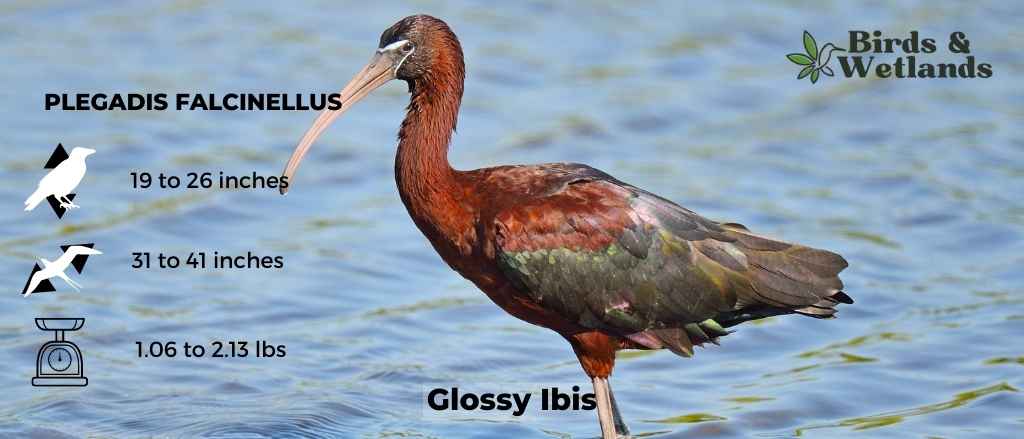
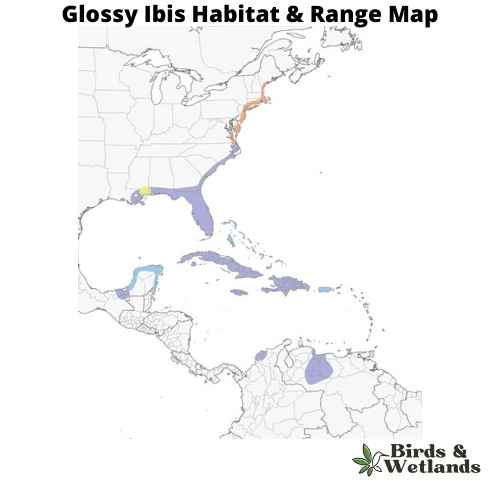
Listen:
Scientific Name: Plegadis falcinellus
Length: 19–26 in
Wingspan: 31–41 in
Weight: 1.069 to 2.138 lb
The Glossy Ibis is a wading bird that has an extensive global range, including parts of the United States, and is the most widespread of all ibis species.
Appearance: The Glossy Ibis is characterized by its slender, curved bill and dark, iridescent body. Its feathers are a rich chestnut and dark green, which appear metallic and shiny, thus giving it the name ‘Glossy’. In breeding season, the area around the bird’s eyes becomes a bright, striking blue.
Diet: Glossy Ibises feed primarily on invertebrates such as insects, worms, and small crustaceans. They use their long, curved bills to probe for food in soft mud, often following the tide in coastal marshes, but also in shallow freshwater wetlands.
Reproduction: Glossy Ibises typically nest in colonies, often with other wading birds. The nests are made from twigs and reeds and are usually placed in trees, shrubs, or reed beds over water. The female lays 3 to 4 blue-green eggs, which are incubated by both parents for about 21 days. Once hatched, the chicks are cared for by both parents and fledge at about 6 weeks.
American Coot
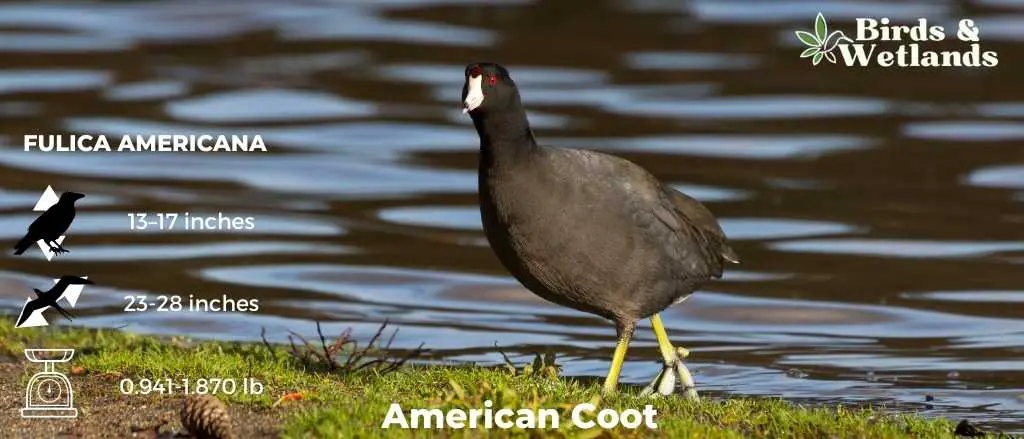
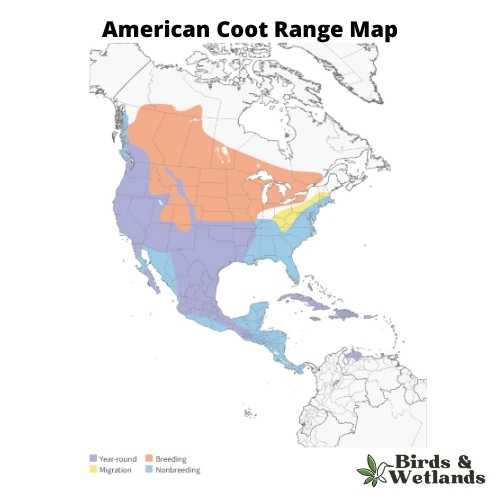
Listen:
Scientific Name: Fulica americana
Length: 13–17 in
Wingspan: 23 to 28 in
Weight: 1.270 to 1.870 lb
The American Coot is a ubiquitous water bird commonly seen in the wetlands, lakes, and ponds of North America, recognized for its adaptability and striking features.
Appearance: American Coots are easily identifiable by their slate-gray bodies, offset by a white, chicken-like bill and a red eye. Their legs are also distinctive, equipped with lobed toes, as opposed to the webbed feet seen in ducks, which assist them in navigating both land and water adeptly.
Diet: While aquatic plants form the bulk of an American Coot’s diet, they aren’t strictly herbivores. These versatile birds also consume small invertebrates and fish, demonstrating their ability to adapt and survive in a variety of habitats.
Reproduction: Nesting for the American Coot usually happens in shallow water bodies, where they construct a floating nest hidden among the vegetation. A clutch can contain between 8 to 12 eggs, all of which are incubated by both parents.
Mallard
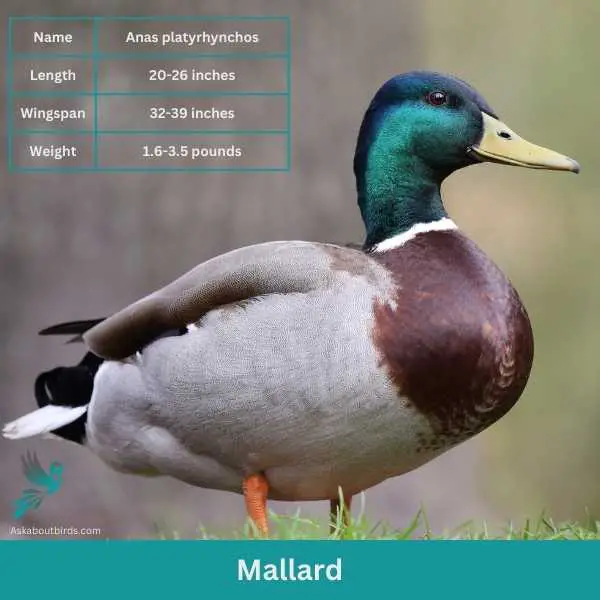
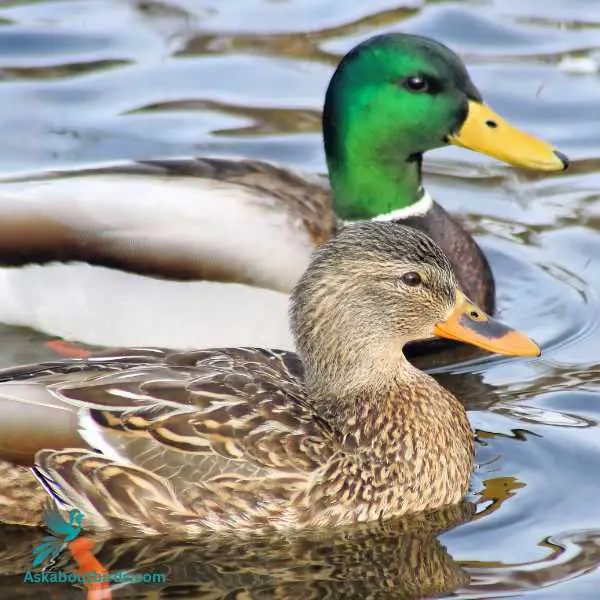
| Feature | Measurement |
|---|---|
| Scientific Name | Anas platyrhynchos |
| Length | 20-26 inches |
| Wingspan | 32-39 inches |
| Weight | 1.6-3.5 pounds |
The Mallard, one of the most recognizable of all ducks, is distinguished by its classic “quack” and its common presence in city parks and wild wetlands.
Appearance: Mallards are large ducks with a hefty body and rounded head. The male is notable for its glossy green head, gray body, and black tail-curl, while the female is mottled brown with an orange-brown bill. Both sexes have a white-bordered, blue “speculum” patch in the wing.
Diet: Mallards are omnivorous, dabbling ducks that eat a wide variety of foods. They are known to feed on aquatic vegetation, insects, worms, and grains. In city parks, they are often seen eating bread, popcorn, and other food provided by humans, although such items are not part of their natural diet.
Reproduction: Mallards nest on the ground on dry land that is close to water, under cover of tall grass or other vegetation. The female typically lays around 8 to 13 eggs and incubates them herself.
Wood Duck
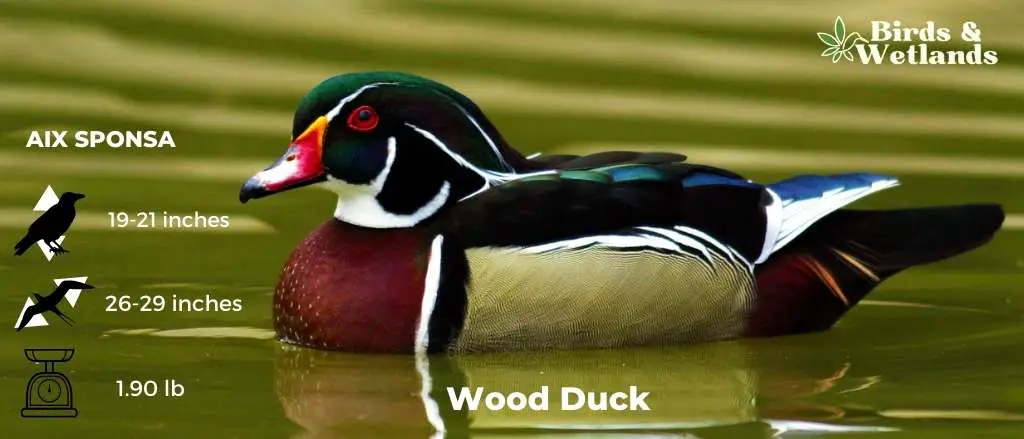
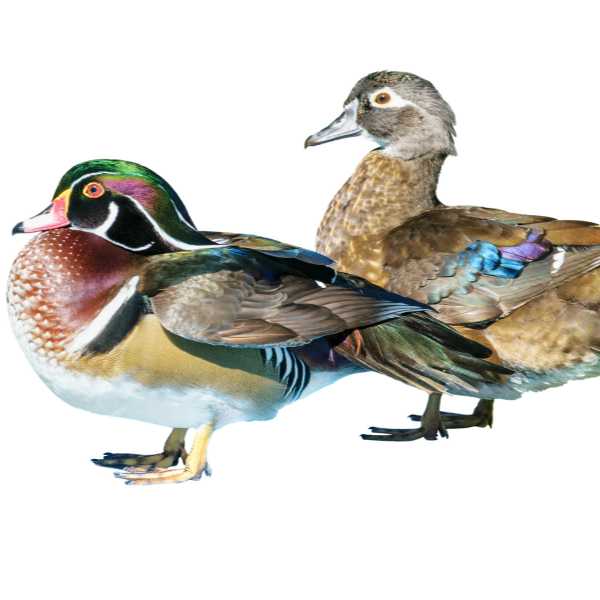
Listen:
Scientific Name: Aix sponsa
Length: 19 to 21 in
Wingspan: 26 to 29 in
Weight: 16.0-30.4 oz
The Wood Duck is an exquisitely colorful waterfowl known for its unique nesting habits and is commonly seen in wooded swamps, marshes, and streams across North America.
Appearance: With their dazzling plumage, Wood Ducks are among the most stunning birds. Males display a multitude of colors, including a green and purple crested head, red eyes, and a white-striped chest, all contrasted with a bronze-colored body. Females, though more subdued with a gray-brown body and white eye-ring, also possess their own charm.
Diet: Wood Ducks have a diverse diet that includes seeds, fruits, and insects, as well as other invertebrates. Their broad diet helps them to adapt to a variety of habitats, whether in the wild or in urban areas with suitable nesting sites.
Reproduction: Unlike most other ducks, Wood Ducks prefer to nest in tree cavities near water, leading to their common name. They will also readily use nest boxes if they’re available. A typical clutch consists of 9 to 14 eggs, which the female incubates alone.
Common Merganser
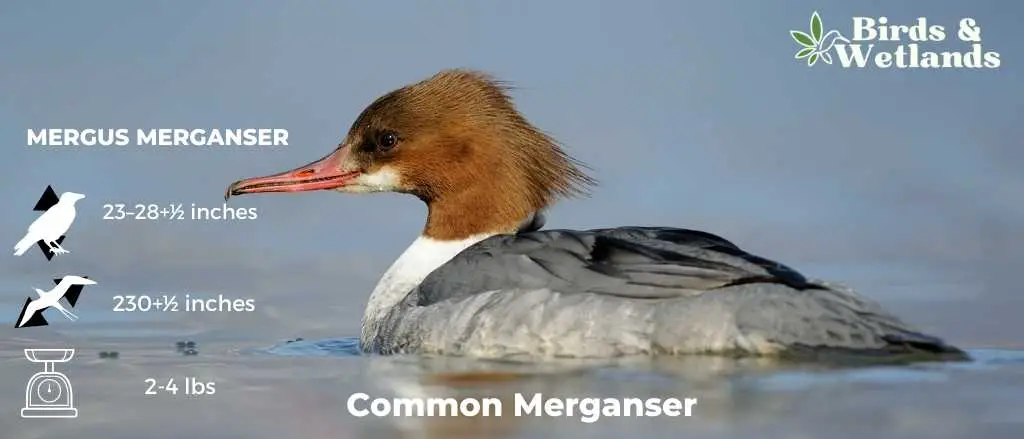
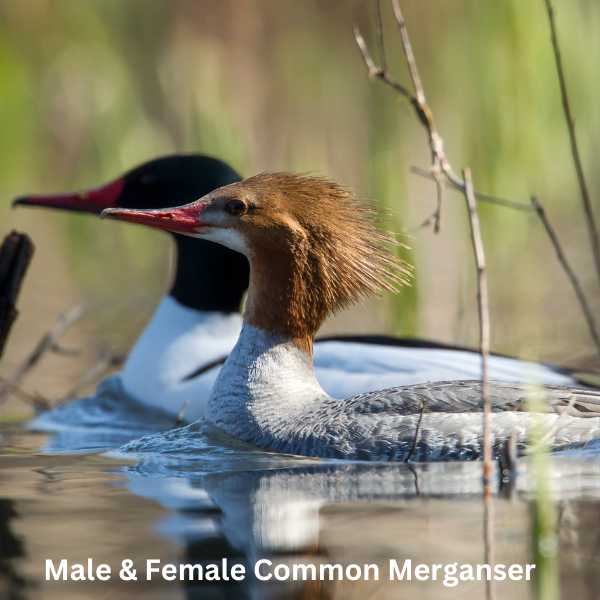
Listen:
Scientific Name: Mergus merganser
Length: 23–28 in
Wingspan: 30 – 38 in
Weight: 2 lb 0 oz – 4 lb 10 oz
The Common Merganser is a large and elegant diving duck, famous for its unique fishing abilities and seen often in the lakes, rivers, and coastal areas across North America.
Appearance: The male Common Merganser is quite striking with its dark green, almost black, crested head, bright red bill, and white body tinged with salmon-pink. The females have a reddish-brown crested head, a white neck, and a grayish body, but share the same red bill as the males.
Diet: True to their diving duck status, Common Mergansers are exceptional hunters, primarily feeding on fish. They’re also known to consume aquatic invertebrates and, on occasion, small mammals and birds. Their serrated bills are specialized to hold slippery fish tightly.
Reproduction: Like the Wood Duck, Common Mergansers also nest in tree cavities or nest boxes close to water bodies, but can also use rock crevices or holes in the ground. A clutch usually contains 9 to 12 eggs, incubated solely by the female.
Hooded Merganser
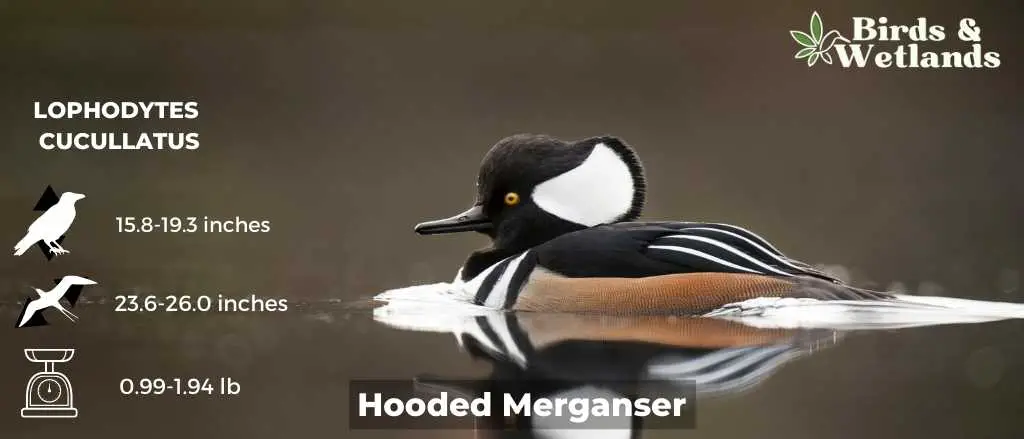
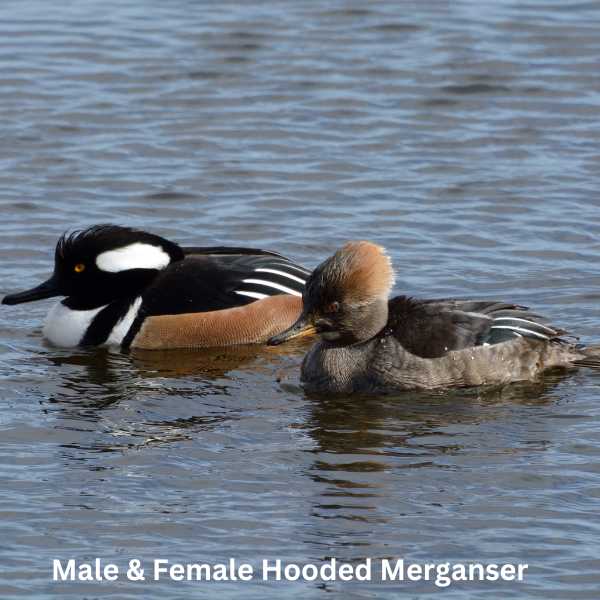
Listen to Hooded Merganser
Scientific Name: Lophodytes cucullatus
Length: 15.8-19.3 in
Wingspan: 23.6-26.0 in
Weight: 16.0-31.0 oz
The Hooded Merganser is a distinctive species of diving duck known for its showy crest and its excellent diving skills.
Appearance: Male Hooded Mergansers are especially striking with a large, fan-shaped, black and white crest, which can be expanded or contracted. They have bright yellow eyes, a dark back, and a white chest. The females have a more understated appearance with a brownish body, a smaller, reddish-brown crest, and dark eyes.
Diet: Consists of small fish, aquatic insects, and crustaceans. Their eyes are specially adapted for underwater vision, allowing them to spot and catch prey while diving.
Reproduction: Similar to Buffleheads, Hooded Mergansers often nest in tree cavities near water bodies. The female lays a clutch of about 10 to 12 eggs and incubates them alone for about a month.
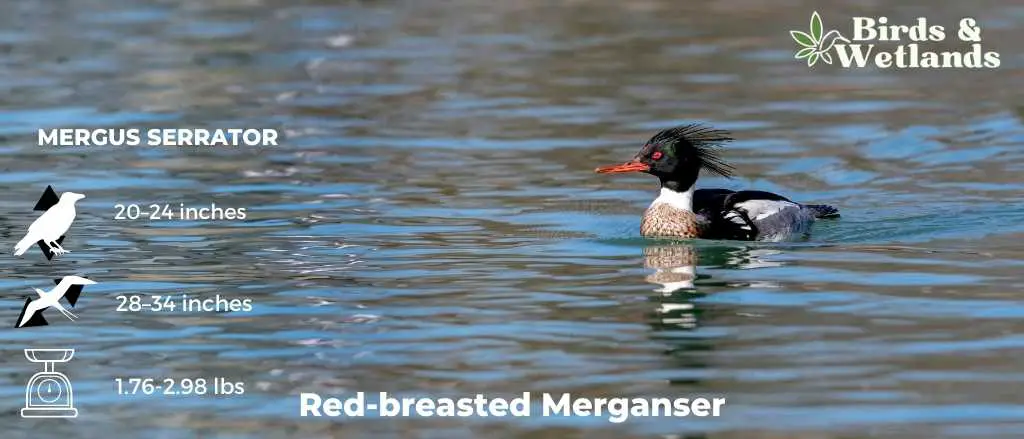

Listen
Scientific Name: Mergus serrator
Length: 20–24 in
Wingspan: 28–34 in
Weight: 28.2 to 47.6 oz
The Red-breasted Merganser is a fascinating diving duck species, recognized for its swift flight and exceptional diving capabilities. They inhabit freshwater and saltwater environments and are quite common in North America and Eurasia.
Appearance: The Red-breasted Merganser boasts an interesting appearance. Males display a dark green head, bright red eyes, and a distinctive, long reddish-brown breast. Their bodies are mainly grey, and they also have a white collar and a thin, serrated bill. Females are more subdued, featuring a rusty cinnamon head with a shaggy crest and grey body.
Diet: Predominantly includes small fish, which they catch by diving underwater. They can also feed on aquatic insects, crustaceans, and occasionally amphibians. Their serrated bill helps them grip slippery prey effectively.
Reproduction: The breeding ground for Red-breasted Mergansers is typically near freshwater lakes or rivers. Females build nests in tree cavities, on the ground hidden in vegetation, or use abandoned nests of other birds. The female lays a clutch of 6 to 12 eggs.

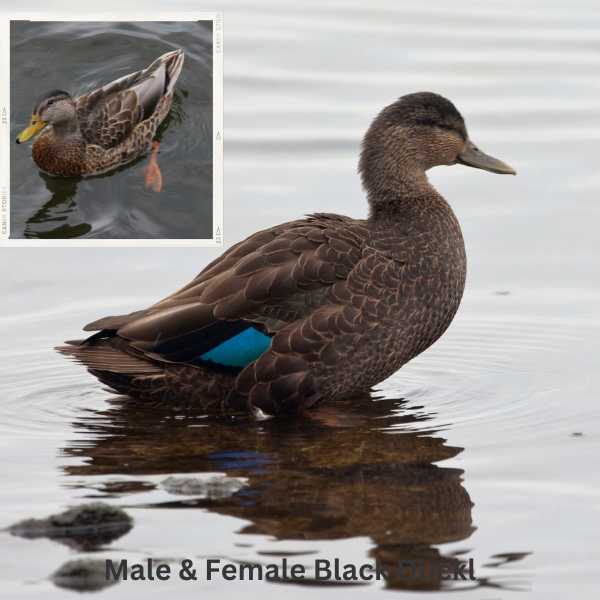
Listen
Scientific Name: Anas rubripes
Length: 21–23 in
Wingspan: 35–37 in
Weight: 1.59–3.62 lb
The Black Duck is a relatively large species of waterfowl known for its dark plumage and distinctive, richly flavored meat.
Appearance: Both male and female Black Ducks sport a similar look. They are predominantly dark brown in color with a lighter, beige-colored underbelly. They feature a yellowish-green bill, and their wings, when spread, reveal a purple-blue speculum bordered by two black bands.
Diet: Black Ducks primarily subsist on plant matter. They feed on seeds, leaves, and roots of aquatic plants, as well as grasses and crops. In addition, they sometimes eat small fish, insects, and aquatic invertebrates. These ducks can often be spotted foraging in shallow water bodies and marshlands.
Reproduction: Black Ducks typically create their nests on the ground, preferably in secluded, well-hidden spots near water bodies. The female usually lays a clutch of about 6 to 12 eggs, which she incubates for about four weeks.
Blue-winged Teal
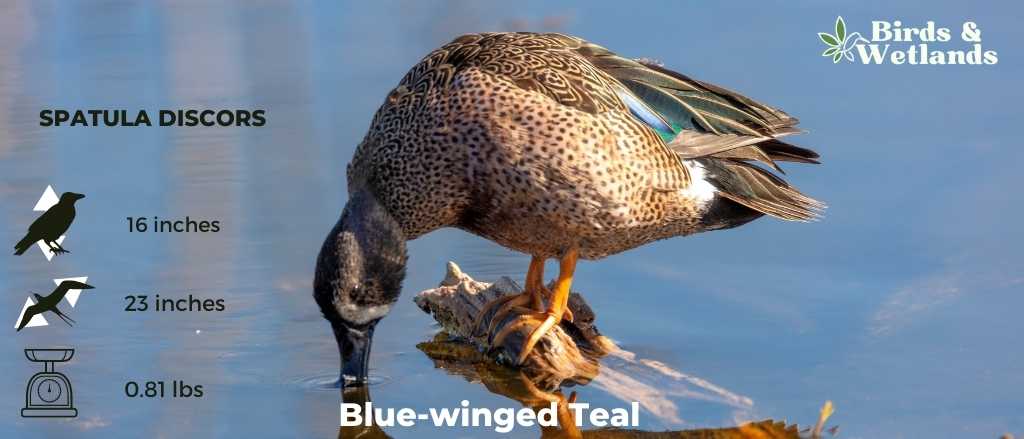
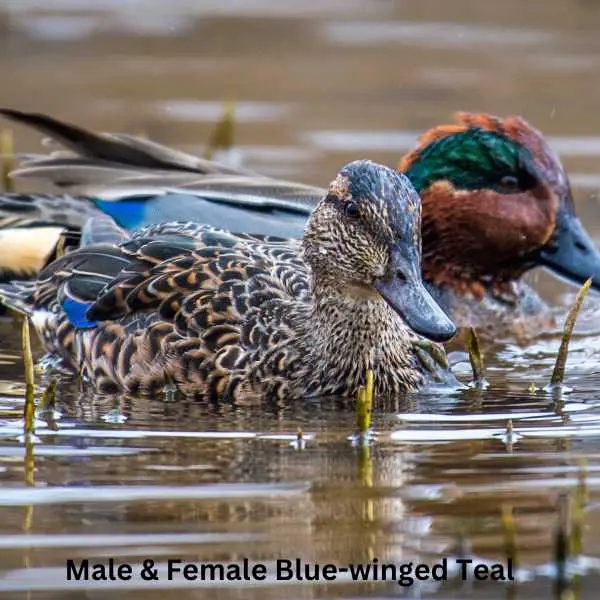
Listen to Blue-winged Teal
Scientific Name: Spatula discors
Length: 16 in
Wingspan: 23 in
Weight: 13 oz
The Blue-winged Teal is a small species of dabbling duck known for its striking plumage and its extensive migratory habits.
Appearance: Male Blue-winged Teals are quite colorful, with a slate gray head and neck, a white crescent in front of the eyes, and a predominantly brown body with specks of black. The name “Blue-winged” comes from the patch of blue feathers visible on their wings during flight. Females, in contrast, are primarily brown and subtly mottled to provide camouflage.
Diet: The Blue-winged Teal feeds mainly on plant matter, such as seeds and aquatic vegetation. However, they also supplement their diet with small invertebrates, especially during the breeding season. They are known for their “dabbling” behavior, where they feed at the surface of the water rather than diving.
Reproduction: Blue-winged Teals prefer to nest on the ground in grassy areas near water. The female typically lays a clutch of 9 to 13 eggs, which she incubates alone for about three weeks. After hatching, the ducklings can feed themselves but remain under the mother’s protection until they are capable of flying.
Northern Pintail
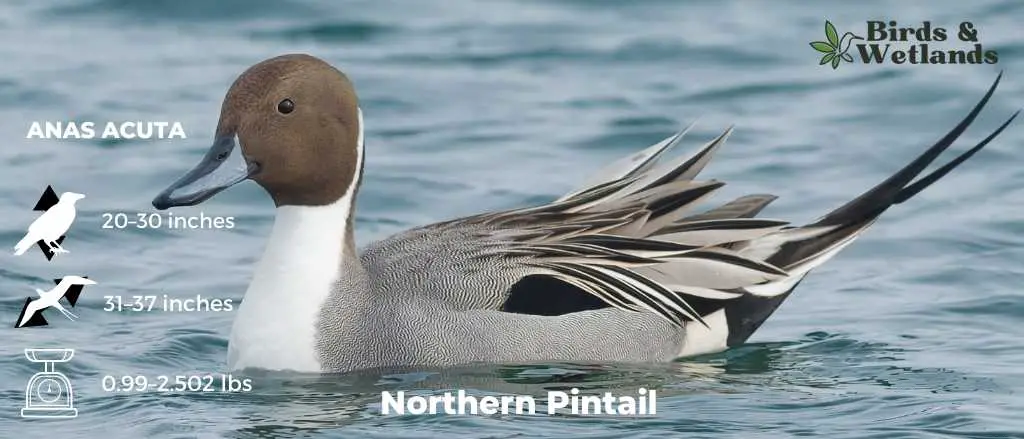
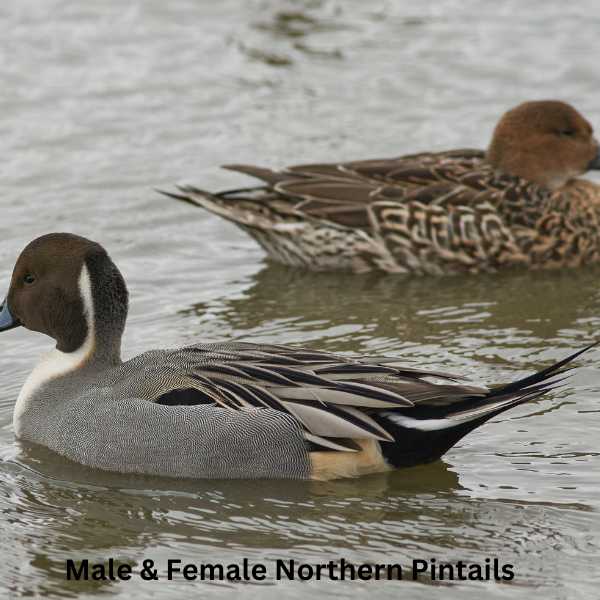
Listen to Northern Pintail
Scientific Name: Anas acuta
Length: 23–30 in
Wingspan: 31–37 in
Weight: 1 –3 lb
The Northern Pintail is a graceful species of duck recognized for their elegance in flight and their sleek bodies and long tails which is pin-shaped.
Male Northern Pintails are celebrated for their distinctive appearance, featuring a chocolate brown head, a white neck, and a grayish body. The most notable characteristic is the long, pointed tail feathers, which give this species its name. Females are more understated in color, sporting a mottled brown plumage.
Diet: Consists primarily of plant matter, including seeds and aquatic vegetation. They are also known to eat insects, especially during the breeding season. The Northern Pintail is often seen dabbling and upending in water bodies to forage for food.
Reproduction: Northern Pintails usually nest on the ground, near water bodies. The female lays a clutch of 7 to 9 eggs and is solely responsible for their incubation, which lasts for about three weeks.
Green-winged Teal
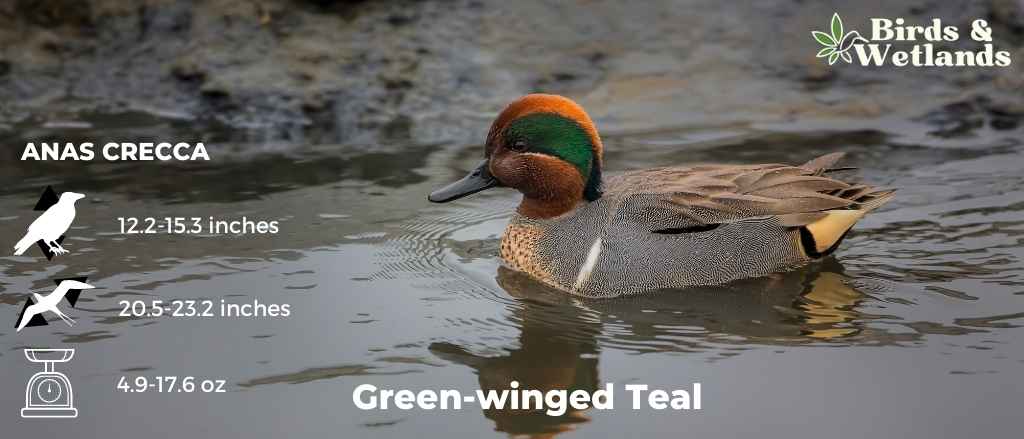
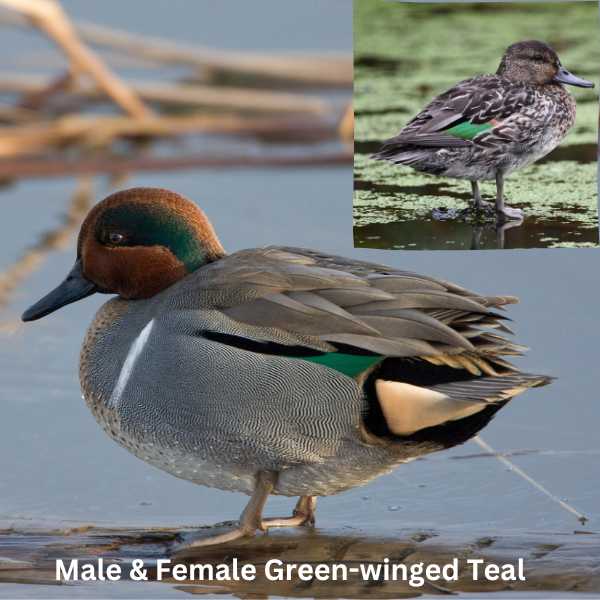
Listen to Green-winged Teal
Scientific Name: Anas crecca
Length: 12.2-15.3 in
Wingspan: 20.5-23.2 in
Weight: 14.9-17.6 oz
The Green-winged Teal is a small species of dabbling duck known for its vibrant coloration and quick, agile flight.
Appearance: Male Green-winged Teals are particularly striking with a chestnut head, a broad green streak running from the eye down the neck, and a speckled chest. The name “Green-winged” originates from the patch of iridescent green feathers visible on their wings. Females are more subtly colored, primarily in mottled brown tones that provide excellent camouflage.
Diet: The Green-winged Teal’s diet consists largely of plant matter such as seeds and aquatic vegetation. They also eat small invertebrates, particularly during the breeding season. These birds are ‘dabblers.’
Reproduction: Green-winged Teals typically nest on the ground, often concealed in dense vegetation near water bodies. The female lays a clutch of about 6 to 9 eggs, which she incubates alone for roughly three weeks.
Ring-necked Duck (Aythya collaris)
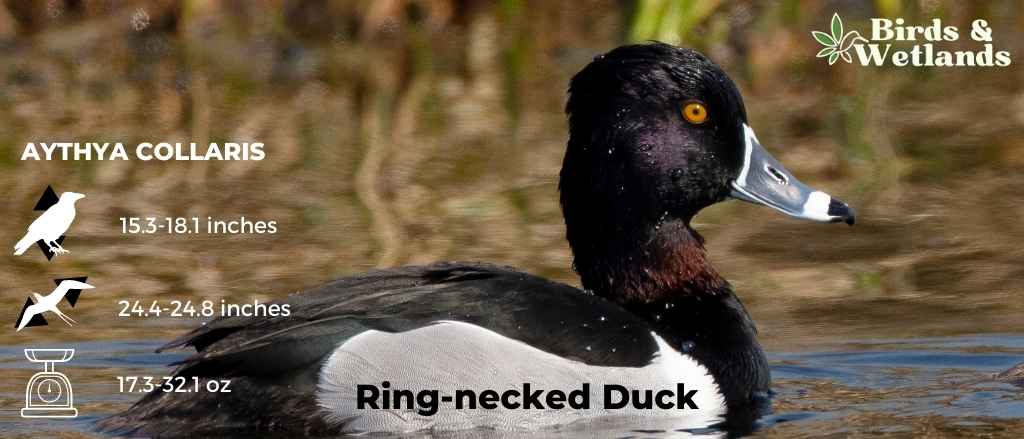

Listen
Scientific Name: Aythya collaris
Length: 15.3-18.1 in
Wingspan: 24.4-24.8 in
Weight: 17.3-32.1 oz
The Ring-Necked Duck is a small to medium-sized diving duck known for its distinctive markings and agile diving abilities.
Appearance: Male Ring-Necked Ducks are characterized by their bold black-and-white coloration, with a glossy black back, a striking white ring around the base of the bill, and two white “rings” on their flanks. Despite their name, the chestnut-colored ring around their neck is often hard to see. Females are more subtly colored with a gray-brown body and a white eye-ring.
Diet: These ducks have a varied diet that includes aquatic plants, seeds, and invertebrates, which they obtain by diving underwater in both shallow and deep water bodies.
Reproduction: The Ring-Necked Duck nests near water, often in densely vegetated areas. The female typically lays between 8 to 10 eggs, which she incubates alone, but both parents will care for the ducklings once they hatch.
Canvasback
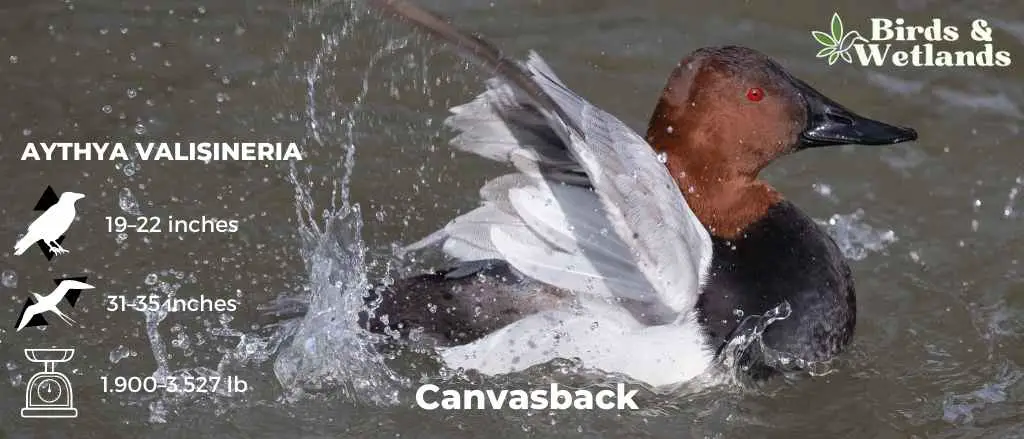
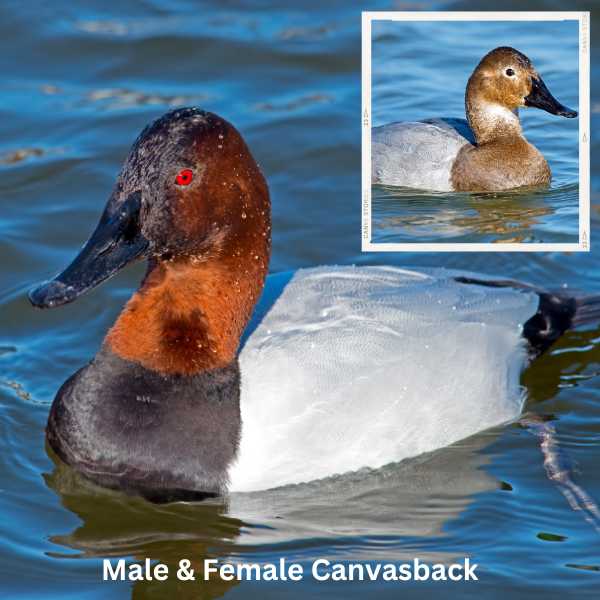
Listen
Scientific Name: Aythya valisineria
Length: 19–22 in
Wingspan: 31–35 in
Weight: 1.900–3.527 lb
The Canvasback is a large diving duck species known for its sloping forehead and long, robust bill. These distinctive birds are primarily found in the wetlands and open water bodies across the United States.
Appearance: Male Canvasbacks are easily recognized by their reddish heads, black chests, and white bodies, which gives the impression of a canvas-like texture, hence their name. Females, on the other hand, have light brown feathers and a slightly paler belly. Both genders have dark gray bills and red eyes.
Diet: Canvasbacks are primarily vegetarian, feeding on aquatic plants like wild celery, pondweeds, and algae. They also occasionally consume small aquatic animals, such as snails, insects, and crustaceans.
Reproduction: Canvasbacks typically nest over water, using marsh plants to construct their nests. The female usually lays a clutch of 5 to 11 eggs which she alone incubates for about a month.
Redhead
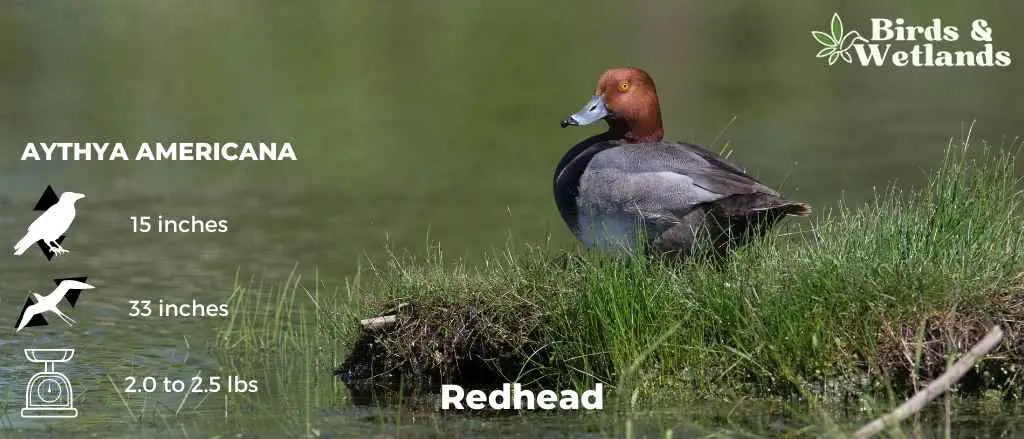
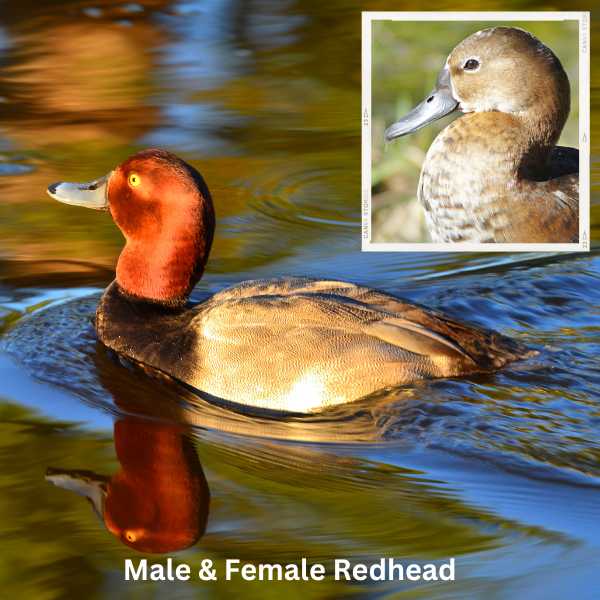
Listen
Scientific Name: Aythya americana
Length: 15 in
Wingspan: 33 in
Weight: 2.0 to 2.5 lbs
The Redhead is a medium-sized diving duck species recognized by its rounded head and broad blue bill. This bird is frequently found in wetlands, ponds, and open water bodies across the United States.
Appearance: The male Redhead is particularly striking, characterized by a coppery red head, black breast, and a gray body. The female is less colorful, featuring a brownish body and a duller, brownish-red head. Both sexes have a prominent blue bill with a black tip.
Diet: Redheads feed on a variety of items, including aquatic plants, seeds, and tubers. They also consume aquatic invertebrates, particularly during the breeding season.
Reproduction: Redheads often nest in marshes and ponds with dense vegetation.Females often lay their eggs in the nests of other ducks, a phenomenon known as brood parasitism. When nesting themselves, the female typically lays a clutch of 7 to 10 eggs and incubates them for about three weeks.


Listen to American Wigeon
Scientific Name: Bucephala clangula
Length: 18-20 inches
Wingspan: 30.3-32.7 inches
Weight: 1.8-2.2 lbs
The Common Goldeneye is a medium-sized diving duck, recognized for its golden-yellow eye and distinct whistling sound made during flight.
Appearance: Male Common Goldeneyes have a glossy green-black head, a circular white patch between the eye and the bill, and a golden-yellow eye. They have a dark back and white underparts. Females have a chocolate-brown head and a similar golden-yellow eye but lack the white facial patch.
Diet: Common Goldeneyes feed on a variety of aquatic life including crustaceans, insects, and small fish. They are diving ducks and will often plunge below the surface to search for food.
Reproduction: The female nests in tree cavities near water, typically laying between six and fifteen eggs. After hatching, the young ducks will follow their mother, who guides them to feeding areas but does not feed them directly.
American Wigeon
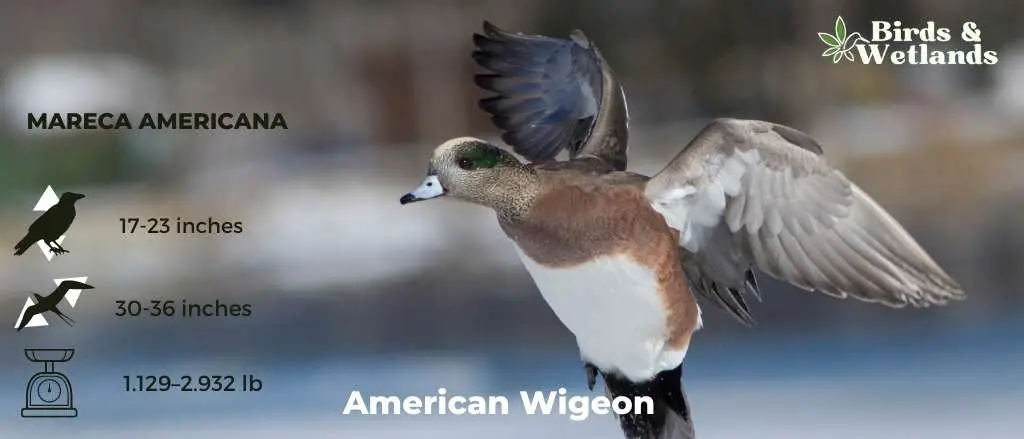
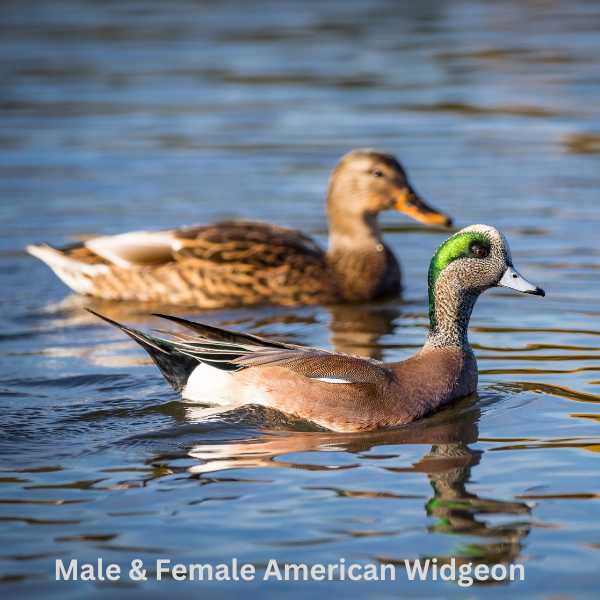
Listen to American Wigeon
Scientific Name: Mareca americana
Length: 17–23 in
Wingspan: 30–36 in
Weight: 1 –3 lb
The American Wigeon is a medium-sized duck species that is a popular sight in wetlands, ponds, and lakes and is often seen in mixed flocks with other ducks.
Males of the species are recognized by their distinctive appearance. They sport a unique white forehead and crown, coupled with a green band stretching from the eye to the back of the head. The body is mainly gray with a pinkish hue on the chest. Females are more subdued in color, with primarily gray and brown tones.
Diet: comprising mainly plant material like aquatic vegetation and grasses, but it also includes insects and other small invertebrates. They are known for a feeding behavior called “kleptoparasitism,” where they often snatch food from other ducks.
American Wigeons usually breed in the northernmost parts of North America. The females create their nests on the ground, often hidden in tall grass near water bodies. They lay a clutch of 6 to 11 eggs which they incubate for about three to four weeks and the ducklings feed on small aquatic invertebrates and aquatic insects.
Northern Shoveler
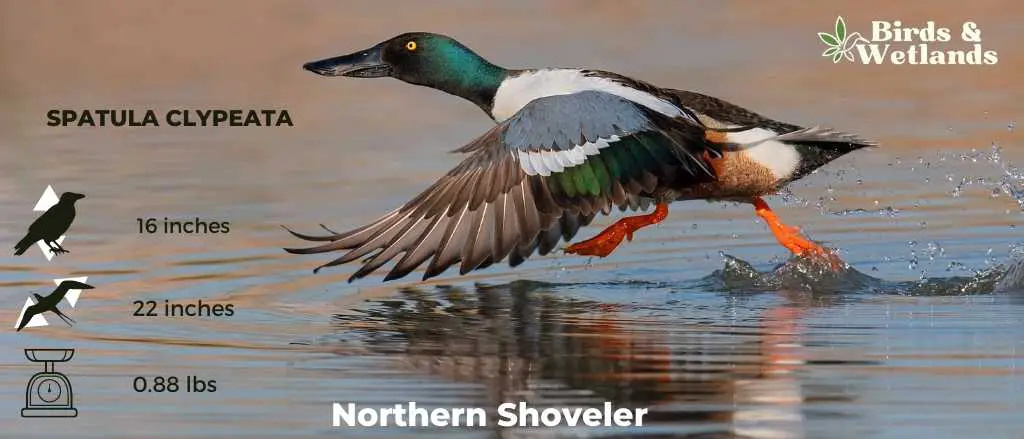
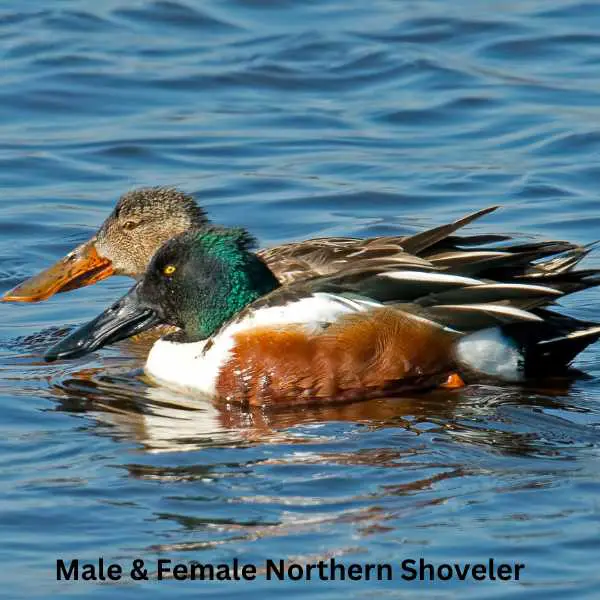
Listen to Northern Shoveler
Scientific Name: Spatula clypeata
Length: 16 in
Wingspan: 22 in
Weight: 14 oz
The Northern Shoveler is a distinct species of dabbling duck celebrated for its long, spoon-shaped bill, a feature that sets it apart from other ducks and gives the bird its name.
Appearance: Male Northern Shovelers are particularly striking, boasting a green head, yellow eyes, a large black bill, and a white chest, complemented by a chestnut-colored body. Females, on the other hand, feature a more muted color scheme, primarily displaying mottled brown feathers across their bodies and a slate-gray bill.
Diet: The Northern Shoveler’s unique bill is perfectly adapted for its feeding habits. The edges of the bill are furnished with comb-like structures that enable the bird to filter food from water. Their diet predominantly consists of aquatic invertebrates and plant matter, including seeds and algae.
Reproduction: Northern Shovelers typically nest on the ground, concealed within dense, grassy areas close to water bodies. The female lays a clutch of about 9 to 12 eggs and is solely responsible for their incubation, which lasts for about three to four weeks.
Where to Spot Delaware’s Water Birds
Bombay Hook National Wildlife Refuge: Situated on the coast, this refuge is a major stop on the Atlantic Flyway. It’s renowned for its extensive tidal salt marsh, freshwater impoundments, and diverse water bird population, including herons, egrets, ducks, and shorebirds.
Prime Hook National Wildlife Refuge: Another crucial habitat on the Atlantic Flyway, Prime Hook is a haven for water birds. The marshes, ponds, and forests attract diverse species, such as migrating snow geese and numerous wading birds.
Cape Henlopen State Park: Located at the point where the Delaware Bay meets the Atlantic Ocean, this park is a migratory hotspot for numerous water bird species. It is also the nesting ground for ospreys and is known for its populations of gulls, terns, and waterfowl.
Delaware Seashore State Park: Located on a barrier island, this park’s diverse habitats, including sandy beaches, marshes, and bays, attract a range of water birds, from herons and egrets to sandpipers and plovers.
Port Mahon: This area near Little Creek is a notable spot for birding. The shoreline and surrounding wetlands are known to attract a variety of water birds, including rare and migrating species.
| Neighboring State | Best Spots for Birdwatching |
|---|---|
| Maryland Water Birds | Blackwater National Wildlife Refuge, Deal Island Wildlife Management Area, Assateague Island National Seashore |
| Pennsylvania Water Birds | Conneaut Harbor, Presque Isle State Park, Middle Creek Wildlife Management Area |
| New Jersey Water Birds | Edwin B. Forsythe National Wildlife Refuge, Cape May Point State Park, Sandy Hook Gateway National Recreation Area |
FAQS on Waterbirds in Delaware?
Are there many wading birds in Delaware bay?
Yes, there are many species of wading birds that you can find in the Delaware Bay, an estuary outlet of the Delaware River on the Northeast seaboard of the United States. There is also a wide range of marsh birds and many other species of birds in Delaware from the bald eagle to backyard birds found around bird feeders.
How many birds are in Delaware?
The exact number of individual birds in Delaware at any given time can be difficult to determine due to factors such as migration, breeding, and varying populations of different species. However, according to the Delaware Ornithological Society there are approximately 420 species of birds that have been recorded in Delaware ranging from the marsh wren, to secretive birds such as Salt Marh sparrows, shore birds with their long legs and even snow geese with their pink legs.

